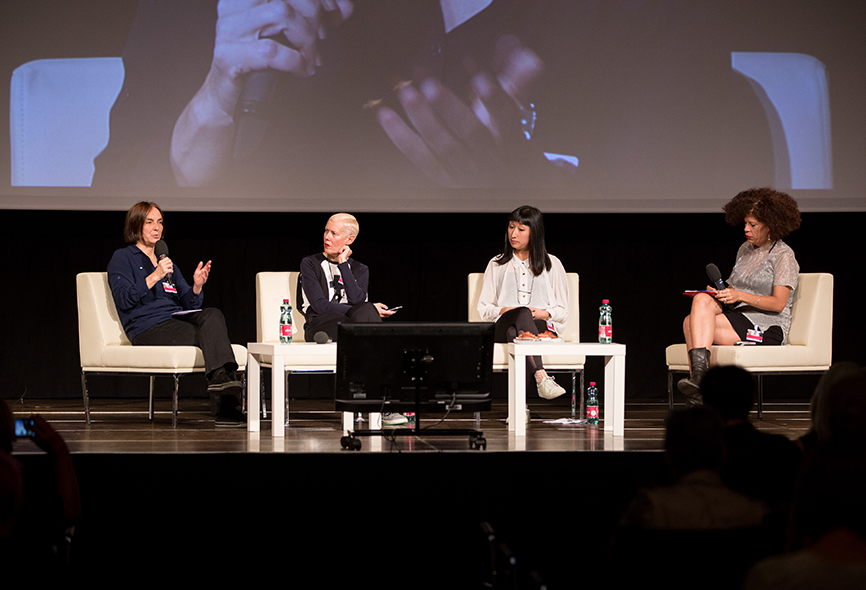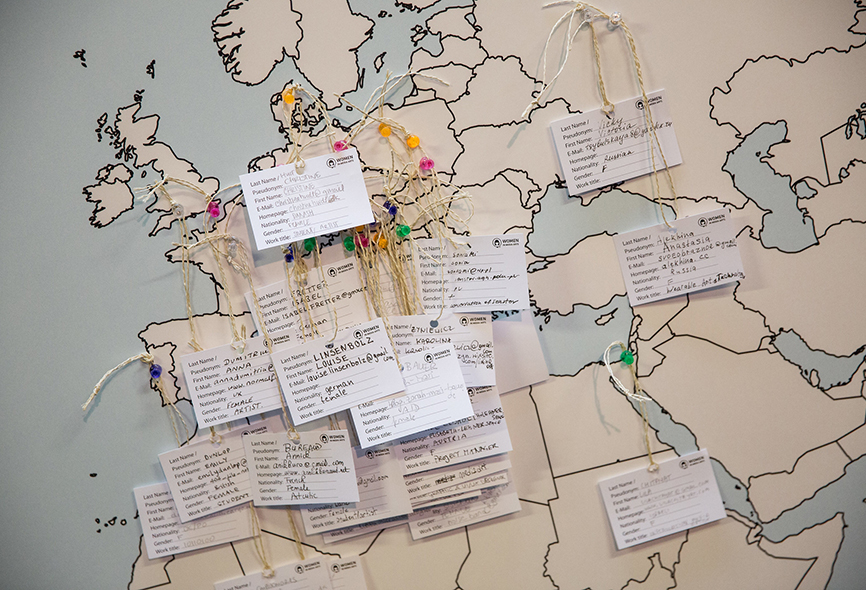The Women in Media Arts database collects all information about female artists who could be found in the Ars Electronica Archive. In 2017, it was opened to the public to enable contributions concerning female media artists in general. Still a work in progress, the archive is and will be updated frequently.
One of our former colleagues, Elena Robles Mateo, is currently doing her PhD in networks of collaboration between women in media arts. Her research aims to track the interaction and active participation between female artists around the world since the 1990’s in order to understand how women in technology-related arts are connected and which alternative ways of working they are using. The objective of this research is to create an overview of the worldy flow of female artists in digital and electronic arts and to show how strong and of which quality the connexion between them is. The research project is carried out at the Universitat Politècnica de València in Spain, and the results will be published by the beginning of 2020. Beforehand, she spoke to us about the background of her work, the importance of female networks and findings of her survey.
You are currently doing your PhD in networks of collaboration between women in media arts. What is the aim of your research?
Elena Robles Mateo: In my research I want to map a series of past and contemporary curatorial and organizational practices that have been developed collectively by female artists at the intersection of art and technology: exhibitions, platforms, creative networks, projects, archives, workshops, spaces, symposiums, associations, etc. I am interested in studying these all-women self-organized and collaborative projects and networks that have taken place within the general panorama of new media arts since the middle 1980s. Some of them happen at a local level based on a space, while others are translocal networks that combine real-face encounters with virtual communication. Others exist uniquely online like virtual exhibitions. I want to understand the context that has given rise to these initiatives, its relation and influence of feminist theories and what has been their form of organization, as most of them have occurred in the grassroots or margins of a wider scenario without funding and based in voluntary work. Finally, with the results I want to create a visualization map of these initiatives by location, year and typology that works as the first step for a further visualization project on the networks of activity, collaboration and influence between the members of them worldwide.

How did you develop the topic of your research?
Elena Robles Mateo: When I finished my fine arts bachelor I got interested in art practices related to digital society. I started studying collaborative digital works and platforms and due to personal experience I started to be more interested in women’s practices. While trying to find all-women collaborative works in digital arts, instead I came through several artist-run organizations and platforms dedicated to supporting women in the field and to provide alternative forms of technology learning through art and criticism. As I started to gather a wide range of women-only and feminist projects in arts and technology, I wondered if there was a relation between all of them, and concretely what was the context that gave rise to them since the first to the current ones. Despite differences between them, the general premise to find such initiatives is that women are low in numbers in technology and in new media arts, having as a common premise the fact that the way technology is portrayed regarding women and society must be challenged. The male dominant tech environment has been an issue since the first computer labs and festivals in the USA and Europe. If similar projects are emerging would it mean that nothing has changed in three decades for women in new media arts? There are diverse approaches to address these issues, as many as feminist positions, from more formal to more radical and critical ones.
Can you explain how this is all connected with the Women in Media Arts project of Ars Electronica?
Elena Robles Mateo: The archive of Ars Electronica was one of the first cases that I found when I started my digital research. Although it is not artist-run, the archive is the main archival source of women in new media arts worldwide. The center and the festival in Linz are clues in the history and network of new media arts since the late 1970s. For my research, having the possibility to access a series of female artists that have taken part in it, in addition to others, it’s a great input to start locating the geographical zones of activity internationally. I also had the opportunity to meet the team behind the archive – Veronika Liebl, Florina Costamoling and Christina Radner – and since then I have received a kind support from them for my work which I consider is very relevant, as collaboration across disciplines and across institutions is necessary to be able to develop projects to support and promote women’s work. With the support of the archive I could conduct a survey to track all-women initiatives in new media arts that were inaccessible due to language and location barriers, and mainly because they mostly happen in the grassroots with little promotion online.

The official results aren’t published yet but can you give us a quick insight?
Elena Robles Mateo: I have come to the conclusion that women find potential ways to gather and create spaces on their own in new media arts with a strong commitment for alternative education and creativity. Unfortunately, due to the scarce financial support that these networks generally have, many of them remained in a project phase that could not be continued, platforms lost on the web, programs that didn’t find support to be performed. Nowadays, international platforms such as UNESCO are interested in promoting women in new media arts in non-Western countries, however, in Europe most of the female networks work with a low funding or by voluntarily work. Regarding the networks, I have found two opposite facts: on the one hand having a general overview of these practices internationally has enabled me to identify a series of artists that are the nodes of the international network of women projects in new media arts. Once I started to locate the names of the founders and core members of my case studies, I realized that many of them have been actively involved in other projects in other periods, some of them even founding several initiatives. In the end, these are trans local networks, women doing things on their own in different parts of the world which are connected by its personal or professional network, influencing each other. If you track the activity of the founders and members of one initiative, it will probably lead you to further activism practices in other locations. On the other hand, some of them have emerged in different periods or simultaneously with no correlation whatsoever. Like some ideas have appeared at the same time in different locations and its members do not know about each other’s work, and the same happens with recurrent projects that are still coming up with methodologies or formats similar to past ones from which they have no record of connection.
Another finding that has surprised me, is that, the situation for women in the US with their first experimental labs and festivals in computer arts was much different than the one in Europe in the 1980s and 1990s. Female artists, despite the low number, used to work in mixed groups in the US with no feeling of discrimination based on gender, and they had an institutional support that was very different here in Europe. One fact is that a woman of color, Lucia Grossberger, was one of the first artists to use a Mac II to make art in California in the middle 1980s. Female artists used to collaborate with Silicon Valley, for example Judy Mallloy, however it is very hard to believe nowadays. As new technologies have developed, the situation regarding diversity and collaboration across-disciplines has not improved at all.

How do feminist technology and arts networks look like now, 2019, compared to the 90s?
Elena Robles Mateo: Feminist theories influence the methodologies of organization of women’s practices in new media arts. The topics of interest have changed from the first practices relate to embodiment and gender liberation in cyberspace to a current awareness for climate change, online sexual harassment, technology accessibility and diversity issues. Most of the networks I have studied target a wider audience than ‘only women’, they are not based on gender but are more focused on unrepresented folks in technology and new media arts. Besides the problematic of women underrepresentation in the fields, the contemporary networks aim to provide alternative spaces for everyone who feels discriminated based on ethnicity, sexual orientation, social class, gender identity, etc., providing non-commercial technology learning formats, more hierarchical, collaborative and interactive. Also, formats regarding mentorship and hands-on, DIY workshops are part of most of the programs and strategies of the contemporary networks. There are also new forms of collaboration between these grassroots networks and cultural institutions that enable them to perform their activities. Also, the nodes of activity have spread from Europe and North America to Latin American countries, Middle East and Asia. It is very interesting to see how other cultures adopt formats of cyber feminism or feminist hackerspaces born in Western societies in their specific contemporary panorama.
For you as a researcher, was there anything surprising about the answers?
Elena Robles Mateo: During my survey I found that female artists over forty years feel an additional discrimination because of their age or because of their motherhood, a fact that in my opinion has not really been addressed yet. Another fact is that contemporary emerging female new media artists generally do not know about the main international platforms and networks for women in their field like FACES mailing list. In addition, I have found that academic literature on North American women-only and feminist spaces in the 1970s and 1980s has eclipsed the local European activisism, leading to the erasure of local feminist spaces and groups in that period. This only emphasizes the necessity for a formal archive available for female artists and general public about these projects, an alternative historiography and bibliography of the previous and existing activism that other female artists have developed.
I think an awareness is strongly necessary of the collective women’s effort that has happened to create alternative spaces of support, activism and collaboration in new media arts. There are so many things that women have organized in computer arts before and outside cyberfeminism, for example, and that is not registered in books.
What is the outlook, what happens after you publish your results?
Elena Robles Mateo: I will publish the results of this research in the digital platform of my personal project: www.atenea.in, where there will be an open archive with the results and the visualization of the initiatives worldwide. I would like to continue with my research in a postdoctoral phase where I can bring my results to an interactive map visualization of the transnational network of the initiatives’ members. I am very much interested in the idea of the network as a sculpture from American artist Anna Couey, so I have some ideas to develop digitally and analogically the network visualization, maybe through an international exhibition besides a digital platform. And I want to keep on working with other women from other disciplines, I am already in touch with people interested in working on the project together and bringing it to a further level.

Elena Robles Mateo is currently research assistant and PhD candidate at Universitat Politècnica de València in the Art History, Audiovisual and Cultural Management Department. She is doing her dissertation in women’s networks and feminist collectives in the intersection of arts and technology. She is one of the main founders of Atenea Project (atenea.in) and her main research focuses are cultural and visual studies, digital society, digital aesthetics, women’s studies, feminisms, digital and electronic arts, cyberfeminism, networked feminism, performing arts and technology, collaborative creation, cultural management.
